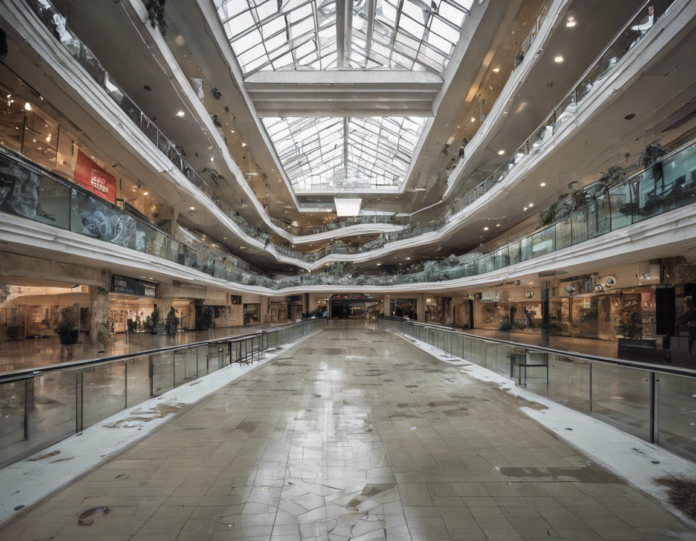In a world where online shopping has become increasingly dominant, the haunting abandonment of ghost shopping malls stands as a stark reminder of the changing retail landscape. These once bustling hubs of consumerism now sit empty, serving as ghostly relics of a bygone era. In this blog post, we will explore the phenomenon of ghost shopping malls, examine the reasons behind their demise, and consider the implications for the future of retail.
The Rise and Fall of Shopping Malls
Shopping malls were once the epitome of consumer culture in the United States. In the mid-20th century, these sprawling complexes offered a one-stop shopping experience, bringing together retailers, restaurants, and entertainment venues under one roof. Malls became social hubs where friends and families gathered to shop, dine, and catch a movie.
However, the rise of e-commerce and shifting consumer preferences have taken a toll on traditional shopping malls. Today, many malls struggle to attract foot traffic as online retailers offer convenience, competitive pricing, and a virtually unlimited selection of products. As a result, numerous shopping malls have fallen into disrepair, with anchor stores closing, storefronts sitting empty, and once bustling corridors now eerily quiet.
The Haunting Beauty of Ghost Shopping Malls
Ghost shopping malls evoke a sense of melancholy beauty, with their abandoned storefronts, faded signage, and empty escalators. These deserted spaces stand as eerie testaments to the relentless march of time and the impermanence of consumer culture. Photographers, urban explorers, and artists are drawn to these decaying relics, capturing their haunting beauty in images that speak to the fragility of human-made structures.
Reasons Behind the Demise of Shopping Malls
Several factors have contributed to the decline of shopping malls and the rise of ghost malls:
- E-commerce – The convenience of online shopping has lured consumers away from traditional brick-and-mortar stores, leading to a decrease in foot traffic at shopping malls.
- Changing Consumer Preferences – Younger generations prefer experiences over material possessions, seeking out unique boutiques, local shops, and artisanal products.
- Overexpansion – The 1980s and 1990s saw a boom in mall construction, leading to oversaturation in many markets and increased competition for retailers.
- Anchor Store Closures – The closure of major department stores like Sears and JCPenney has dealt a severe blow to many shopping malls, causing smaller tenants to follow suit.
Repurposing Ghost Shopping Malls
As shopping malls struggle to adapt to the changing retail landscape, developers and city planners are exploring ways to repurpose these abandoned spaces:
- Mixed-Use Development – Transforming ghost malls into mixed-use developments that combine residential, office, and retail spaces.
- Community Centers – Converting malls into community hubs that offer educational facilities, healthcare services, and recreational activities.
- Entertainment Complexes – Repurposing malls as entertainment complexes with movie theaters, arcades, and fitness centers.
- Green Spaces – Creating urban parks and green spaces within abandoned malls to enhance local aesthetics and promote sustainability.
The Future of Retail
The haunting abandonment of ghost shopping malls serves as a cautionary tale for the future of retail. As e-commerce continues to reshape the way we shop, traditional retailers must adapt to survive. Embracing technology, enhancing the in-store experience, and fostering community engagement are key strategies for retailers looking to thrive in an increasingly digital world.
In conclusion, the phenomenon of ghost shopping malls is a poignant symbol of the shifting tides of consumer culture. These abandoned spaces tell a story of decline and transformation, raising important questions about the future of retail and the role of brick-and-mortar stores in the digital age. As we navigate these changes, it is essential to remember the lessons of the past and embrace innovation to shape a vibrant and sustainable retail landscape for generations to come.
FAQs (Frequently Asked Questions)
1. What is a ghost shopping mall?
A ghost shopping mall is an abandoned shopping center that has fallen into disuse due to factors such as e-commerce competition, changing consumer preferences, and anchor store closures.
2. Why are shopping malls struggling?
Shopping malls are struggling due to the rise of online shopping, oversaturation in the market, changing consumer preferences, and the closure of anchor stores.
3. How can ghost shopping malls be repurposed?
Ghost shopping malls can be repurposed as mixed-use developments, community centers, entertainment complexes, and green spaces to revitalize the space and meet the needs of the local community.
4. What lessons can retailers learn from ghost shopping malls?
Retailers can learn the importance of adapting to changing consumer preferences, embracing technology, enhancing the in-store experience, and fostering community engagement to thrive in the digital age.
5. What does the future hold for retail in the age of e-commerce?
The future of retail lies in innovation, sustainability, and community engagement. Retailers must adapt to the digital landscape, create unique experiences for customers, and build strong connections with local communities to succeed in the evolving retail industry.

